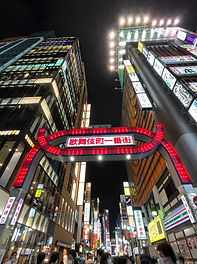
Public Signage (Hayato Okazoe)
MAPPING
This page will discuss how the various public signboards are laid out in the district
Public signboards: Signboards which are issued by public organizations (e.g., government, district bodies…) that are not utilized for business / profit intentions
Introduction
This page will organize how the various public signboards in Kabuki-cho are geographically laid out in the district. Through the process of collecting data subjects, we have found out that there are some visibly recognizable patterns in terms of the geographical layout of the signboards. This is reasonable, as public signboards reflect what is going on in the district. For instance, a frequent placement of signboards citing ‘No Littering’ would perhaps indicate how littering is common in that particular area. This page will discuss the patterns by the various types of public signboards in the area. (some subcategories are omitted due to the lack of subjects)
📍The colored pins on the map indicate:
Purple - Landmarks
Yellow - No kyakuhiki (barkers, catches)
Green - No littering
Orange - No parking (including bicycles)
Black - No smoking
Dark blue - Information
Violet - Others
Tourism / Creating the flashy cityscape
The pins indicating the category of ‘tourism’ and ‘creating the flashy city scape’ are colored in purple on the map above. Geographically analyzing its’ placement, we can see how such signboards are likely to be placed in intersections of relatively big streets, where human flow is dense compared to other areas. For instance, the signages shown in the two images below indicate the exact intersections of where it is placed. Considering the intentions of promoting and flourishing the district, placement of such signboards in crowded areas is understandable.

Security / Maintaining civic order
Kyakuhiki
The pins indicating the category of “no kyakuhiki” are colored in yellow on the map above. Geographically analyzing its’ placement, we can see how such signboards are likely to be placed in the Izakaya district, where kyakuhiki often takes place. In particular, Chuo-dori (Godzilla street) and Sakura-dori were the two most prominent streets with such signboards. These streets (including Ichiban-gai) also have public announcements played which asks the public to be aware of kyakuhiki. Considering the immense number of kyakuhiki going on in the area as well as its’ dense human flow, frequent placement of such signboards there is acknowledgeable.
Ichiban-gai signage (intersection of Ichiban-gai and Yasukuni-dori)

No kyakuhiki signboard in Sakura-dori
No parking (including bicycles)
The pins indicating the category of “no parking” are colored in orange on the map above. Geographically analyzing its’ placement, we can see how the majority of such signboards are placed in the host / hostess district and love hotel district (northern side of Hanamichi-dori). This pattern can be explained by the vast amount of bicycles being parked in that area. Compared to the southern side of Hanamichi-dori, the number of bicycles being parked is absurdly high. Therefore, it is suggested that signboards calling for the prohibition of parking is proportionate to such number.

No bicycle parking in the host club district

Sakura-dori signage (intersection of Sakura-dori and Yasukuni-dori)

No-kyakuhiki signboard in Chuo-dori

No bicycle parking in the host club district
Conclusion
This page discussed the geographical mapping of the various types of public signboards in Kabuki-cho and its’ patterns of placement. From the comparison with the patterns and what is going on around that particular area, we were able to acknowledge how the placement of signboards are not made randomly but rather have intentions to it, in order to successfully meet its’ aim. However, this project did NOT pick up ALL the public signboards in the area, and the subjects of observation are very limited. Therefore, more patterns may be revealed through future research.
.png)